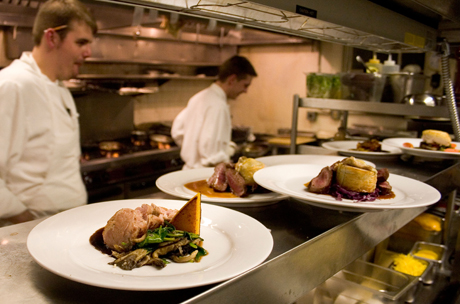 |
|

| Aged to Perfection |
| Pop Art |
| Bottling Up Success |
| Edible Art |
Edible Art: Wisconsin Chefs Create Masterpieces in the Kitchen |
||||||
| Continued... | ||||||
And dining in Wisconsin is changing. Especially in Madison, Muramoto added, diners are seeking out a new, different experience in restaurants and a new perception of food.
“I’m just different from everybody else,” Muramoto said. “I was born in Japan. I grew up in Japan, so I know something different to cook than all other cooks. It doesn’t mean I’m good, just different. That’s something new to Madison, I think that’s why I’m doing so well.” Lazzareschi said people are becoming more educated and interested in food, especially with the increase of restaurants in the Madison area. "They’re learning and they’re developing and there are a lot of good restaurants making good meals," he said. "People are starting to understand what good food is.” Wave Kasprzak, chef and co-owner of The Dining Room at 209 Main in Monticello, attributed the change in Wisconsin dining to the availability and diversity of ingredients now available to restaurants. While locally sustainable ingredients, such as produce grown on state farms, thrive among Wisconsin restaurants, chefs are able to obtain any ingredient they need to create their art. “The world is really getting smaller,” Kasprzak said. “We might get someone who’s visiting from the east coast say, ‘I’ll never order fish in Wisconsin, you can’t get fresh fish in Wisconsin.’ Well, that’s a big lie. We can get fish 24, 48 hours out of the water anywhere in the U.S.” Diners in Wisconsin should try going into a restaurant, even into a local diner down the street, with a new outlook and perception about the food served. The chef cooking the dish is, in fact, creating art to be appreciated and enjoyed. “When people come into a restaurant for an experience, they should just be open,” Wright said. “They should just be ready for that new experience.” Kasprzak recommended ordering multiple appetizers, entrees and desserts. Although it could be too much food for one sitting, try a little bit of everything and take it home for later. For a new take on food, ask the chef to do a tasting menu. In a tasting menu, Urbieta explained, instead of guests choosing their meals, a chef cooks a multi-course meal. Every course has different textures and flavors, including meat, vegetable, cheese and more in miniature portions presented beautifully. “The chef is creating something that is your print,” Urbieta said. “They express something different. You can understand how cooking is a form of art when the chef creates the menu.” Scott Johnson, chef at Captain Bill’s in Middleton, whose cooking philosophy is simply “fresh, fresh, fresh,” agreed the best way to maximize the dining experience is to let the chef create food freely. “Like a painter already knows what it looks like before it’s done, that’s what you do when you cook,” Johnson said. “You already know what you want to do. That’s the best way to do it, to just say whatever the chef says is good today. They know what’s fresh that day.” Chefs in Wisconsin are creating art before our very mouths. How the flavors, colors, textures all combine to create a dish is an experience for diners–an experience Wright says American society still misses too often and Wisconsin independent restaurants are trying to re-establish. “I’m all about reclaiming our food traditions,” she said. “I’m very concerned about the generation of kids who started out with Pop Tarts for breakfast and ended up with McDonald’s for dinner.” Dining can be more than a meal. It can be an artistic experience. The vision a chef starts with, how a plate will look, is realized in the final presentation. The essence of the art of cooking lies in how the chef gets from a mental picture of a dish to presenting it to a guest for a visual taste experience. “What you can imagine has to be executed, and that’s why chefs are artists,” Wright said. “You can think a whole bunch of stuff and read a whole bunch of books and know a whole bunch of stuff, but whether or not you can get what you envisioned onto that plate and have it taste good, and turn out the way you want it to, that’s the challenge." |
||||||
About Us | Contact Us | Business Partners | Archives | Sitemap
Copyright 2007 Curb Magazine
